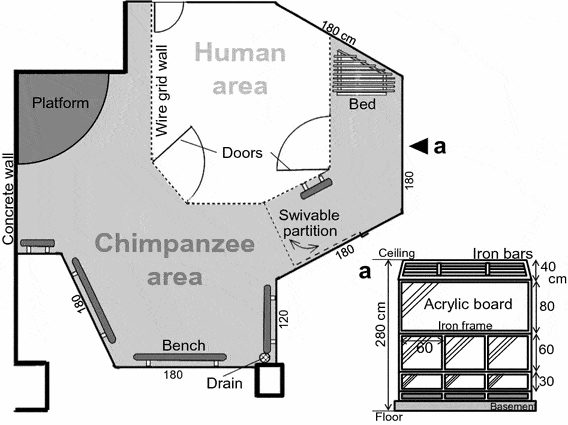
In 2006, Reo the chimp became paralyzed from the neck down due to a spinal chord inflammation. But the chimp fought back and was able to recover enough to stand up and, later, pull himself upright using suspended ropes. There was still a matter of regaining the function of his legs, though. Gently and with a lot of patience, researchers of the Primate Research Institute at Kyoto University devised a novel physiotherapy that enabled Reo to walk using his feet ten years later.
Like most chimps from the Institute, Reo is well versed in using a touch screen to solve cognitive tasks. As a reward, he would receive a tasty treat. Although Reo had not used touch screens following his disability, Yoko Sakuraba of Kyoto University and colleagues tried using computerized tasks to help the chimp regain the function of his legs.
The setup was very simple. A tablet computer was placed on the surface of a wall in the lab where Reo had to perform some cognitive tasks, just like the old days. But instead of having the reward readily served after the task was ever, the food was placed on a tray in the opposite end of the room.

At first, the chimp would not cooperate, but the researchers were just as stubborn. They changed the setup seven times until Reo was comfortable enough to attempt to solve the puzzles on the computer screen. And so Reo ended up completing multiple tasks, then moved two meters to pick his food, only to move two meters more to return to his station.
During his first travel, the chimp moved by clinging to a stationary rope, but gradually Reo learned to move in an upright seated position which resembled the side-to-side manner of a penguin walking on land. After many, many rehabilitation sessions Reo was eventually able to walk for up to 500 meters during two-hour long sessions.
“Cognitive tasks may be a useful way to rehabilitate physically disabled chimpanzees, and thus improve their welfare in captivity,” says Sakuraba.
The story is indeed touching because it shows our primate cousins have at least just as much determination to regain bodily functions as humans do. This is important because it shifts the animal care paradigm, which in such situations advises euthanasia. Dr. Sakuraba says many disabled primates, and perhaps non-primates too, could use this treatment aided by humans to regain movement. She cautions, however, that just like for humans, this operation needs to be custom tailored to the needs and personalities of the patient.
“This study successfully applied a new method of walking rehabilitation using cognitive tasks to a chimpanzee with hind-limb disabilities. In particular, total distance walked increased, and the chimpanzee voluntarily participated in the process. Though Reo initially appeared fearful of the touch monitor and stopped several times during the walking rehabilitation sessions, careful adjustments resolved this problem, leading to the conclusion that personality and physical condition need to be considered when designing and adjusting a rehabilitation program. In addition, this was the first successful rehabilitation method to encourage walking and customized for a chimpanzee, Reo. In the future, we will need to continue rehabilitation exercises, and discuss goals for his continued improvement and well-being,” the authors wrote in the Journal Primates.






